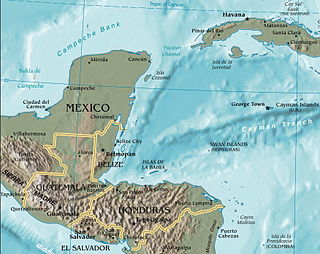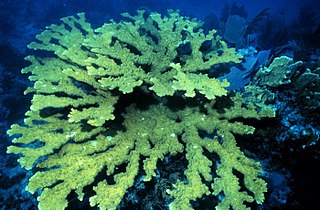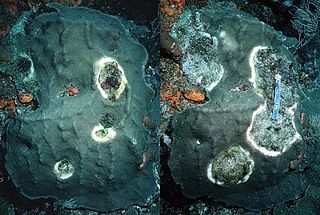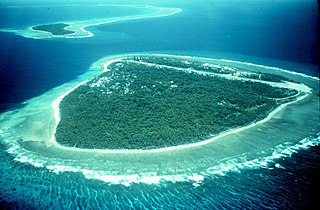
Serratia marcescens is a species of rod-shaped, Gram-negative bacteria in the family Yersiniaceae. It is a facultative anaerobe and an opportunistic pathogen in humans. It was discovered in 1819 by Bartolomeo Bizio in Padua, Italy. S. marcescens is commonly involved in hospital-acquired infections (HAIs), also called nosocomial infections, particularly catheter-associated bacteremia, urinary tract infections, and wound infections, and is responsible for 1.4% of HAI cases in the United States. It is commonly found in the respiratory and urinary tracts of hospitalized adults and in the gastrointestinal systems of children.

The Yucatán Channel or Straits of Yucatán is a strait between Mexico and Cuba. It connects the Yucatán Basin of the Caribbean Sea with the Gulf of Mexico. It is just over 200 kilometres (120 mi) wide and nearly 2,800 metres (9,200 ft) deep at its deepest point near the coast of Cuba.

Acropora is a genus of small polyp stony coral in the phylum Cnidaria. Some of its species are known as table coral, elkhorn coral, and staghorn coral. Over 149 species are described. Acropora species are some of the major reef corals responsible for building the immense calcium carbonate substructure that supports the thin living skin of a reef.

White band disease is a coral disease that affects acroporid corals and is distinguishable by the white band of exposed coral skeleton that it forms. The disease completely destroys the coral tissue of Caribbean acroporid corals, specifically elkhorn coral and staghorn coral. The disease exhibits a pronounced division between the remaining coral tissue and the exposed coral skeleton. These symptoms are similar to white plague, except that white band disease is only found on acroporid corals, and white plague has not been found on any acroporid corals. It is part of a class of similar disease known as "white syndromes", many of which may be linked to species of Vibrio bacteria. While the pathogen for this disease has not been identified, Vibrio carchariae may be one of its factors. The degradation of coral tissue usually begins at the base of the coral, working its way up to the branch tips, but it can begin in the middle of a branch.

Black band disease is a coral disease in which corals develop a black band. It is characterized by complete tissue degradation due to a pathogenic microbial consortium. The mat is present between apparently healthy coral tissue and freshly exposed coral skeleton.

John Pennekamp Coral Reef State Park is a Florida State Park located on Key Largo in Florida. It includes approximately 70 nautical square miles (240 km2) of adjacent Atlantic Ocean waters. The park is approximately 25 miles in length and extends 3 miles into the Atlantic Ocean along the prominent Hawk Channel passage. It was the first underwater park in the United States. The park was added to the National Register of Historic Places on April 14, 1972. The primary attractions of the park are the coral reefs and their associated marine life.

The Staghorn coral is a branching, stony coral, within the Order Scleractinia. It is characterized by thick, upright branches which can grow in excess of 2 meters in height and resemble the antlers of a stag, hence the name, Staghorn. It grows within various areas of a reef but is most commonly found within shallow fore and back reefs, as well as patch reefs, where water depths rarely exceed 20 meters. Staghorn corals can exhibit very fast growth, adding up to 5 cm in new skeleton for every 1 cm of existing skeleton each year, making them one of the fastest growing fringe coral species in the Western Atlantic. Due to this fast growth, Acropora cervicornis, serve as one of the most important reef building corals, functioning as marine nurseries for juvenile fish, buffer zones for erosion and storms, and center points of biodiversity in the Western Atlantic.

Elkhorn coral is an important reef-building coral in the Caribbean. The species has a complex structure with many branches which resemble that of elk antlers; hence, the common name. The branching structure creates habitat and shelter for many other reef species. Elkhorn coral is known to grow quickly with an average growth rate of 5 to 10 cm per year. They can reproduce both sexually and asexually, though asexual reproduction is much more common and occurs through a process called fragmentation.
Skeletal eroding band (SEB) is a disease of corals that appears as a black or dark gray band that slowly advances over corals, leaving a spotted region of dead coral in its wake. It is the most common disease of corals in the Indian and Pacific Oceans, and is also found in the Red Sea.

The Florida Reef is the only living coral barrier reef in the continental United States. It lies a few miles seaward of the Florida Keys, is about 4 miles wide and extends 270 km (170 mi) from Fowey Rocks just east of Soldier Key to just south of the Marquesas Keys. The system encompasses more than 6,000 individual reefs. Florida waters are home to over 500 marine fish and mammal species along with more than 45 species of stony corals and 35 species of octocorals.

Yellow-band disease is a coral disease that attacks colonies of coral at a time when coral is already under stress from pollution, overfishing, and climate change. It is characterized by large blotches or patches of bleached, yellowed tissue on Caribbean scleractinian corals.

Human activities have substantial impact on coral reefs, contributing to their worldwide decline. Damaging activities encompass coral mining, pollution, overfishing, blast fishing, as well as the excavation of canals and access points to islands and bays. Additional threats comprise disease, destructive fishing practices, and the warming of oceans.[2] Furthermore, the ocean's function as a carbon dioxide sink, alterations in the atmosphere, ultraviolet light, ocean acidification, viral infections, the repercussions of dust storms transporting agents to distant reefs, pollutants, and algal blooms represent some of the factors exerting influence on coral reefs. Importantly, the jeopardy faced by coral reefs extends far beyond coastal regions. The ramifications of climate change, notably global warming, induce an elevation in ocean temperatures that triggers coral bleaching—a potentially lethal phenomenon for coral ecosystems.

Looe Key is a coral reef located within the Florida Keys National Marine Sanctuary. It lies to the south of Big Pine Key. This reef is within a Sanctuary Preservation Area (SPA). Part of Looe Key is designated as "Research Only," an area which protects some of the patch reefs landward of the main reef.
Snapper Ledge is a small coral reef located within the Florida Keys National Marine Sanctuary. It lies to the southeast of Key Largo, to the south the Key Largo Existing Management Area and John Pennekamp Coral Reef State Park. Unlike many reefs within the Sanctuary, this reef is not within a Sanctuary Preservation Area (SPA). It is near Pickles Reef. Since 2009, the Coral Restoration Foundation has used Snapper Ledge as a nursery site to grow Elkhorn coral.

Acropora prolifera, the fused staghorn coral, is a branching, colonial, stony coral found in shallow parts of the Caribbean Sea, the Bahamas and southern Florida.
Coral diseases are transmissible pathogens that cause the degradation of coral colonies. Coral cover in reef ecosystems has decreased significantly for a diverse set of reasons, ranging from variable environmental conditions to mechanical breakdowns from storms. In recent years, diseases that infect and kill coral have shown to be a threat to the health of coral reefs. Since the first coral disease was reported in 1965, many different kinds of diseases have popped up in mostly Caribbean waters. These diseases are diverse, including pathogens of bacteria, fungi, viruses, and protozoans. Coral diseases have widespread implications, impacting entire ecosystems and communities of organisms. Researchers are working to understand these diseases, and how potential treatments could stop these pathogens from causing the widespread death of corals in a way that permanently impacts the community structure of reefs.

Stony coral tissue loss disease (SCTLD) is a disease of corals that first appeared off the southeast coast of Florida in 2014. It originally was described as white plague disease. By 2019 it had spread along the Florida Keys and had appeared elsewhere in the Caribbean Sea. The disease destroys the soft tissue of at least 22 species of reef-building corals, killing them within weeks or months of becoming infected. The causal agent is unknown but is suspected to be either a bacterium or a virus with a bacterium playing a secondary role. The degree of susceptibility of a coral, the symptoms, and the rate of progression of the disease vary between species. Due to its rapid spread, high mortality rate, and lack of subsidence, it has been regarded as the deadliest coral disease ever recorded, with wide-ranging implications for the biodiversity of Caribbean coral reefs.

Jamaica, an island located within the Caribbean Sea, known for being a popular tourist destination because of its pristine white sand beaches, is now faced with the issue of mass coral depletion. Both environmental and human factors contribute to the destruction of these corals, which inevitably affect Jamaica's environmental sustainability and economy. Actions have been put in place to counteract the negative consequences associated with the loss of the corals, which act as a symbol of hope for the revival of Jamaica's environment.

Kimberly B. Ritchie is an American marine biologist. She is an Associate Professor in the Department of Natural Sciences at the University of South Carolina Beaufort. Her research is focused on marine microbiology and how microbes affect animal health in hosts such as corals and sharks.

Iliana B. Baums is a professor at Pennsylvania State University known for her work on coral reef ecology.



















